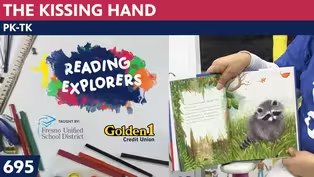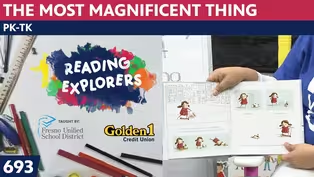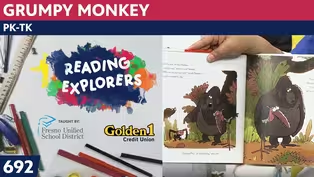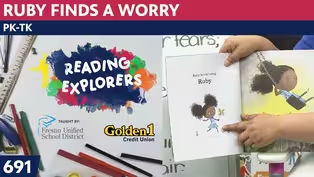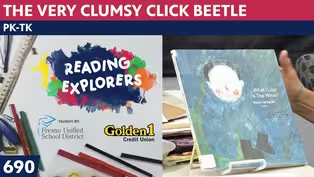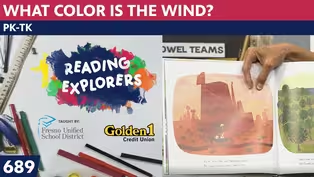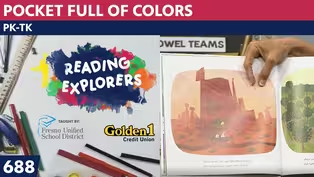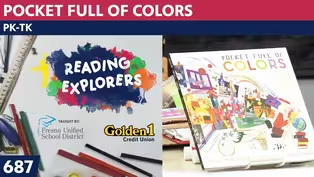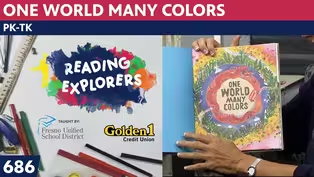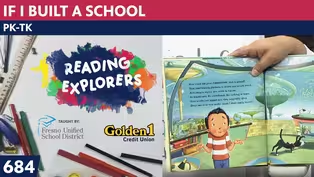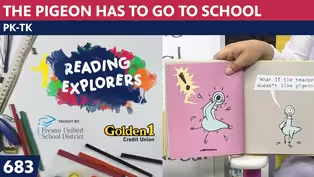
PK-326: Egg-cellent Experiment
Season 3 Episode 131 | 14m 11sVideo has Closed Captions
Join Mrs. Lara at Camp Discovery!
Pre-Kindergarten teacher, Mrs. Lara, welcomes students back to Camp Discovery, a fun learning space packed with reading adventures & fun games!
Problems playing video? | Closed Captioning Feedback
Problems playing video? | Closed Captioning Feedback
Reading Explorers is a local public television program presented by Valley PBS

PK-326: Egg-cellent Experiment
Season 3 Episode 131 | 14m 11sVideo has Closed Captions
Pre-Kindergarten teacher, Mrs. Lara, welcomes students back to Camp Discovery, a fun learning space packed with reading adventures & fun games!
Problems playing video? | Closed Captioning Feedback
How to Watch Reading Explorers
Reading Explorers is available to stream on pbs.org and the free PBS App, available on iPhone, Apple TV, Android TV, Android smartphones, Amazon Fire TV, Amazon Fire Tablet, Roku, Samsung Smart TV, and Vizio.
Providing Support for PBS.org
Learn Moreabout PBS online sponsorshipMore from This Collection
Valley PBS and Fresno Unified School District have partnered with Golden 1 Credit Union to create Reading Explorers Lessons for grades Pre-Kindergarten through Third grade. The daily lessons will be taught by Fresno Unified School District teachers and are created to help students practice their reading skills and reinforce lessons during distance learning.
Video has Closed Captions
Valley PBS presents Reading Explorers Lessons for Pre-Kindergarten and TK. (26m 27s)
PK-TK-693-The Most Magnificent Thing
Video has Closed Captions
Valley PBS presents Reading Explorers Lessons for Pre-Kindergarten and TK. (26m 26s)
Video has Closed Captions
Valley PBS presents Reading Explorers Lessons for Pre-Kindergarten and TK. (26m 28s)
Video has Closed Captions
Valley PBS presents Reading Explorers Lessons for Pre-Kindergarten and TK. (26m 28s)
PK-TK-690: The Very Clumsy Click Beetle
Video has Closed Captions
Valley PBS presents Reading Explorers Lessons for Pre-Kindergarten and TK. (26m 22s)
PK-TK-689: What Color is the Wind?
Video has Closed Captions
Valley PBS presents Reading Explorers Lessons for Pre-Kindergarten and TK. (26m 21s)
PK-TK-688: Pocket Full of Colors
Video has Closed Captions
Valley PBS presents Reading Explorers Lessons for Pre-Kindergarten and TK. (25m 58s)
PK-TK-687: Dancing Through Fields of Colors
Video has Closed Captions
Valley PBS presents Reading Explorers Lessons for Pre-Kindergarten and TK. (26m 20s)
PK-TK-686: One World Many Colors
Video has Closed Captions
Valley PBS presents Reading Explorers Lessons for Pre-Kindergarten and TK. (27m 13s)
PK-TK-685: School is Wherever I am
Video has Closed Captions
Valley PBS presents Reading Explorers Lessons for Pre-Kindergarten and TK. (26m 32s)
PK-TK-684: If I Built a School
Video has Closed Captions
Valley PBS presents Reading Explorers Lessons for Pre-Kindergarten and TK. (26m 21s)
PK-TK-683: The Pigeon Has to Go to School
Video has Closed Captions
Valley PBS presents Reading Explorers Lessons for Pre-Kindergarten and TK. (26m 22s)
Providing Support for PBS.org
Learn Moreabout PBS online sponsorship♪ Good morning to a brand new day ♪ ♪ Time to learn and the games to play ♪ ♪ Learning things is so much fun ♪ ♪ Learning is good for everyone ♪ (soft music) - Hello little learners.
Welcome back to our learning space.
My name is Mrs. Lara, can you tell me your name?
I'm so happy that you made it back today.
Should we start off with a song?
Okay, I have my friend helping me today.
It's a new one.
Let's see if you can learn it.
It goes like this.
♪ Good morning, good morning, it's a sunshine kind of day ♪ ♪ Come join Mrs. Lara for some learning and some play ♪ ♪ Will we sing a song?
♪ ♪ Of course we will ♪ ♪ Make our brains strong ♪ ♪ Very super strong ♪ ♪ So come along ♪ ♪ Yes, come on friends ♪ ♪ For some learning and some play ♪ Okay, so let's get started with our schedule for today.
Now today, it's a really fun day.
We're going to start off with our emotional check-in, and today I'm going to show you how to be a feelings superhero.
And then we're going to move on to our weekly investigation.
So this week we're learning about black history month, and all of the African-American people who contributed to our wonderful country.
And then, we're going to sing our good bye song.
Okay so, I told you I would show you how to be a feeling superhero.
So, I went to the place where everything costs $1, and I bought a plastic tablecloth like this, and I cut it in half.
So what I was going to do is make a cape.
I decorated my cape with stickers and a batch.
And then when I put it on, I'm going to be a feeling superhero.
Are you ready to join me?
Okay, I'm going to stand up and put on my cape.
You can put on your pretend cape until you make your own.
Ready?
Here it goes.
A little loud there.
Ooh, look at my cape, I'll make it fly.
And we're going to sing a song, and then we're going to look at our friend here.
Ready?
It goes like this.
♪ Feeling superhero, flying through the air ♪ ♪ Gonna find some feelings, and show people we care ♪ Oh, look, I see a friend.
Her name is Colette.
C, special letter C for Colette.
Hi Colette.
I wonder how Colette is feeling.
What does a superhero do?
That's right, they look at their face for clues.
Let's see.
I noticed that Colette is smiling wide, her teeth are showing.
And she's at a desk.
I wonder if she's going to school.
How does school make me feel?
That might give me a clue about how Colette is feeling.
Hmm, I think Colette is feeling happy.
That's right, I could tell by her smile.
So as a feeling superhero, I'm going to share in her happiness with that big smile.
Thank you so much for sending in your picture Colette.
And boys and girls, if you want to send in your picture and story, please do so to the address below.
And as a special bonus, you get a little booklet from PBS that has stickers and activities if you send in your picture and story.
Okay so, I'm going to take off my superhero cape and put it to the side because I'm going to introduce a concept to you.
So, I'm going to introduce it by flipping some letters.
It's going to spell a word, because letters together make words.
So here's our first letter.
Oh, it's the letter H. H. Then I have the letter I.
What word could I be making?
Hi.
Close.
Then I have an S. His.
No, that's not quite there yet.
Here's a T. Then I have an O.
And I'm going to stand up to grab my R. Histo.
And then my last letter, come on letter, is a letter Y.
Now those are all letters, and together they make a word.
I'm gonna stretch and say it really slow, and then fast.
And as soon as you know that word, I want you to scream it out to your TV.
Are you ready?
History.
History.
History.
History.
That's right.
History.
History is the story of our past.
And this week we're going to learn about black history.
Black history is actually an important part of our country's history.
In black history month, and in all the months of the year, we discover all the contributions that African Americans made to our culture, to the books that we read, to the music that we listen to.
So, here I have a few of my favorite African-American contributors.
I have Louis Armstrong, who was a wonderful jazz musician and whose music I still listen to.
Serena Williams, a master of tennis.
Mae Jemison, one of the first African-Americans in outer space.
Maya Angelou, Muhammad Ali, Faith Ringgold.
And as a bonus, Ms. Readwright is going to learn all about Faith Ringgold.
And she's going to do art with you, so stay tuned for her.
Frederick Douglas, an author.
And Oprah Winfrey, who you might see on TV.
Now, February is black history month because it was two people's important birthdays.
It was Abraham Lincoln and Frederick Douglas.
They were both born in February.
So we thought we'd honor them with a month to honor their heritage.
Now what's important to remember about African-American history and black history month is that it's a history of struggle, and also a history of perseverance and bravery, and a symbol for all the things that we want you boys and girls to be.
So back in the olden days, they used to have what's called segregation.
Segregation's a really big word.
But what it means is that people were divided by the color of their skin.
So they used to have people of color with darker skin that used to have to do one thing.
And people with lighter skin used to have to do another thing.
And the people of color couldn't do the same things that people with lighter skin couldn't do.
So, a lot of these people became to symbolize equality and freedom among everybody.
So really important concept that might be hard for you to know at four years old.
But I want you to think, have you ever had a time when a grownup said to you, you can't do this, you're too small.
Or, oh, you can't play this because you're a girl or you're a boy.
That's that same type of feeling of division that they felt back then when there was segregation.
Now I want you to think too, is it fair that people are treated differently based on the color of their skin?
What's really different about people?
Does skin color make us different?
Hmm, I'm going to go over to my project lab here and we're going to do a little experiment that's going to show us if really skin color matters.
So let's look.
All right, and we're going to do an excellent experiment.
The materials you're going to need to try this at home are a brown egg, a white egg, and a plate or a bowl.
Now we're going to start by examining our brown egg.
Now look.
It is brown on the outside, And look, here's a comparison to our white egg.
Do they look the same?
How are they different?
I want you to think.
Hmm, they have the same basic shape, don't they?
The white egg and the brown egg, both kind of look like the same shape.
The brown egg is different because it's a different color, and the white egg is lighter.
What else can make them different?
I wonder if what is on the inside is different as well.
How can we find out?
I want you to use your thinker.
I want you to think, think, think.
How can we find out what's on the inside of these eggs?
We can crack them open.
Do you think that because one is brown and one is white that they're going to be different on the inside?
Hmm, I wonder.
A good scientists collects data.
So we're going to crack open the egg and find out.
First, let's crack open our white egg.
Are you ready?
Now, if you were going to do this experiment, you might need a parent to help you, because you don't want to be messing with raw eggs.
They could actually make you sick if you get them in your mouth.
Okay, so here's the shell.
I'm going to put that away right here.
And here's what the inside of the egg looks like.
It has a yellow part that we call a yolk, and it has kind of like this white surround.
So that's what the white egg looks like on the inside.
Is that what you thought it would look like?
Now, many of you have not seen these brown eggs.
These are organic eggs.
They are sold in a lot of grocery stores, but they tend to be a little more expensive.
So I want you to think about what the inside of this egg is going to look like.
Just because it's brown, is it going to look different?
Hmm?
Take a moment to pause and think.
Will the yellow part be darker?
Will the white part be lighter?
What's one way we can find out?
What does a good scientists do?
That's right, they experiment, they collect data.
So we are gonna crack open our egg.
Here we go.
And crack.
Wait a minute.
Look, this is the brown egg.
It has the same yellow center, and the same white part all around it.
Boys and girls, are they the same, or are they different?
That's right.
They're the same color, they look the same on the inside.
And this is to show you that regardless of the color of your skin boys and girls, even if it's darker or lighter, we all have the same contents on the inside.
We all have a heart that cares about people.
We all are loving and have a family.
So we shouldn't treat people differently just based on the color of their skin.
Now boys and girls, I want you to think about today, how this is a symbol.
So a symbol is something that represents something else.
Like if you think about a heart, that's a symbol that means love.
So these eggs, this activity, black history month, all of that is a symbol that represents that we should overcome things that scare us, or that are not fair, and that we should fight for what's right, and believe that everyone is equal.
Now before I sing my goodbye song, I want to leave you with this.
Remember that you can be a symbol for all the good things that are happening in the world.
That's what I believe you are.
Okay, let's take some time to sing our song now.
If you have it memorized, you can sing along with me.
And tomorrow, we'll learn more about black history month.
Are you ready?
It goes like this.
♪ A, B, C you later ♪ ♪ D, E, F, G I'm gonna miss you ♪ ♪ H, I have to go now ♪ ♪ J, K bye-bye now ♪ ♪ L, M, N, O I had a good time ♪ ♪ P, Q are you going to miss me?
♪ ♪ S, T, U are my best friend ♪ ♪ V, W, X, Y, Z ♪ Now I hope that you come back tomorrow.
Tomorrow, we're going to be learning about a very special man, Dr. Martin Luther King.
And we're going to be doing another activity.
So, bring your paints and your paper, and I'll show you what we're going to do then.
All right my friends.
Mrs. Lara sends you a big smudge.
Goodbye.
♪ Good morning to a brand new day ♪ ♪ Time to learn and games to play ♪ ♪ Learning things is so much fun ♪ ♪ Learning is good for everyone ♪
Support for PBS provided by:
Reading Explorers is a local public television program presented by Valley PBS
